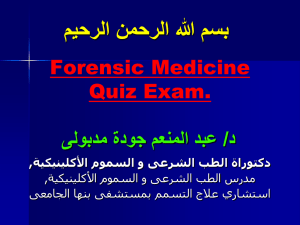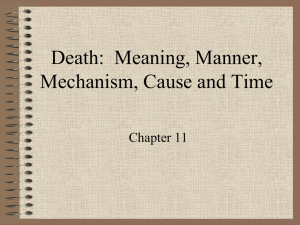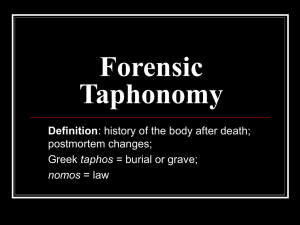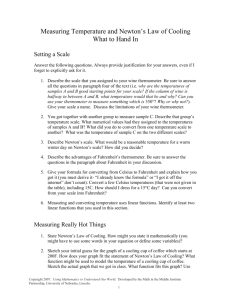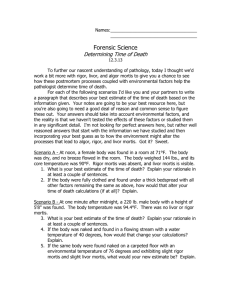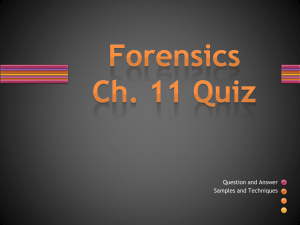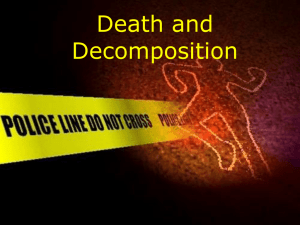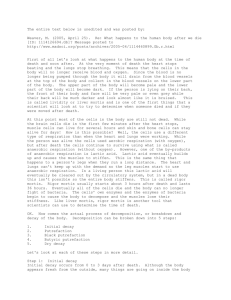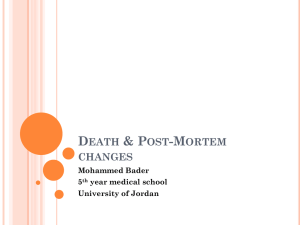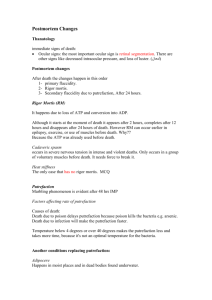Calculus of CSI: Estimating Time of Death
advertisement
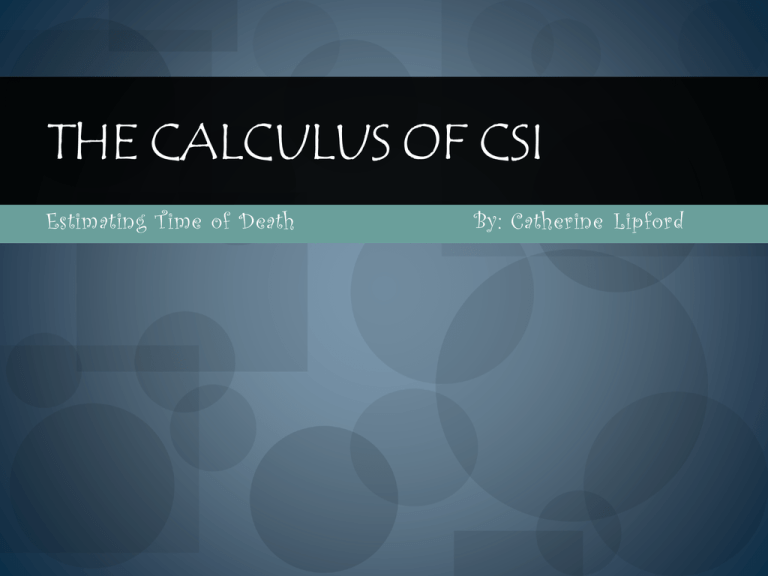
THE CALCULUS OF CSI Estimating Time of Death By: Catherine Lipford The Factors in Estimating Time of Death Rigor Mortis– The gradual muscle stiffening that spreads over the body in the hours after death then fades as gradual as it started. Algor Mortis– The slow cooling of a warm-blooded corpse as it equilibrates with the temperature or its surroundings. Livor Mortis– The dark blue or red discoloration of the skin caused by the pooling of blood due to gravity. This begins the moment blood pressure plummets to zero. **Anywhere from 24 to 48 hours after death, lividity reaches its peak, the body reaches room temperature, and rigor mortis disappears. Therefore, estimating the time of death is more accurate within the 24 hours after death. Anywhere from 2 days or more these factors are no longer valuable in the investigation. Methods for Estimating Time of Death….. The Concurrence Method: Comparing the occurrence of events which took place at known times with the estimated time of death. Examples include: a wrist watch stopped by a blow during an assault or the extent of digestion of the last know meal. The Rate Method: Measuring the change produced by a process taking place at a known rate that was either initiated or stopped by death. Examples include: the amount and distribution of rigor mortis, change in body temperature, and degree of decomposition of the body. Dr. Harry Rainy Rainy was Second Regius Professor of Forensic Medicine at the University of Glasgow. He was the first to find and relate a formula for estimating time of death in the mid 1800’s He was also criticized for his lack of knowledge and understanding in Forensics outside of the medicine field. However, due to the formula having such strict stipulations, such as, the environmental temperature had to be a constant 98 degrees, the formula was not considered further. Newton’s Law of Cooling Newton’s Law of Cooling: The original formula for Newton’s Law of Cooling is…… The rate of change in the temperature of an object is proportional to the difference between the object’s temperature and the temperature of the surrounding medium. By using this formula, one can solve for t which is time, by using integration. After solving for t, the equation will be…. Algor Mortis with Newton’s Law Newton’s Law of Cooling was originally applied to smaller masses with known starting temperatures, but after deriving another formula from the integrated original, one can apply Newton’s Law with body temperature to estimate the body’s cooling rate. The derivation formula that is specific for estimating the time of death of a body is as stated below. = time in hours = Body temperature (°F) = Room temperature (°F) The Case of the Murdered Accountant After a busy evening of income calculations an accountant was found dead in his office. At 10:00 a.m. the coroner measured the body temperature to be 85.6 °F, then again at 12:00 p.m. it was 82.6 °F. The room temperature was measured to be a constant 70 °F. *Assuming the body temperature at death was 98.6 °F, what would the estimated time of death be to the nearest minute? Solution… 10hrs – 6.061hrs = 3.93hrs = 3:56 a.m. 12hrs – 8.197hrs = 3.80hrs = 3:48 a.m. At 10:00a.m. : Time of death interval: 3:48 a.m. to 3:56 a.m. Estimated time of death: 3:52a.m. At 12:00p.m. : Why Time of Death? Estimating the time of death is of great importance to the police investigators working on a murder case and/or finding a hidden cause of death. It gives a time interval in which further investigation is needed. It also allows investigators to rule out a suspect due to a legitimate alibi during that time interval. Therefore, the estimation of the time of death is ranked very high on the to-do list of crime investigation. Works Cited http://webpages.csus.edu/~sac46677/process.htm http://www.pstcc.edu/facstaff/tlcrossl/1730_4_5.pdf http://regentsprep.org/Regents/math/algtrig/ATE9/logsResource.htm http://www.thenewdetective.com/Resources/eZine.html Snyder Sach, Jessica. Corpse: Nature, Forensic Science, and the Struggle to Pinpoint Time of Death. New York: Da Capo Press, 2001. Axelrod, Alan, and Guy Antinozzi. The Complete Idiot’s Guide to Criminal Investigation. Indianapolis: Alpha Books, 2003.
